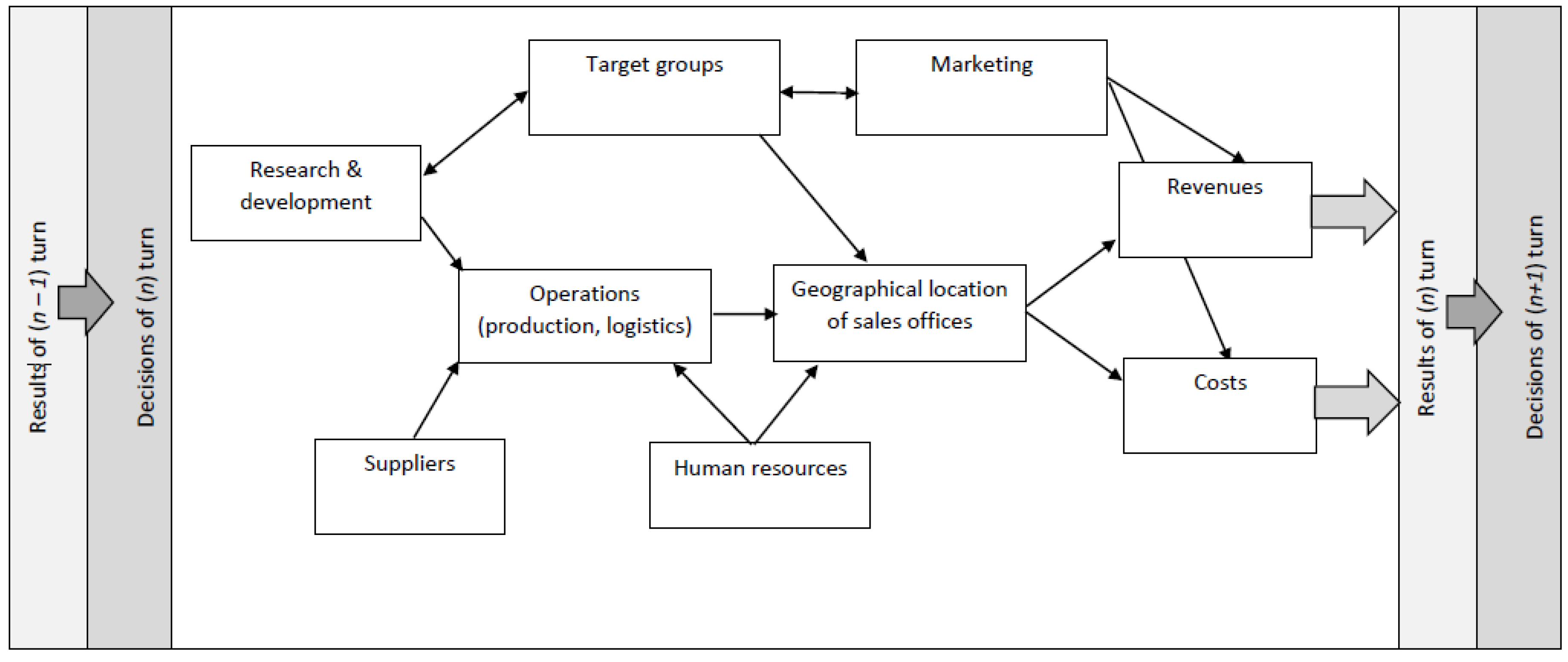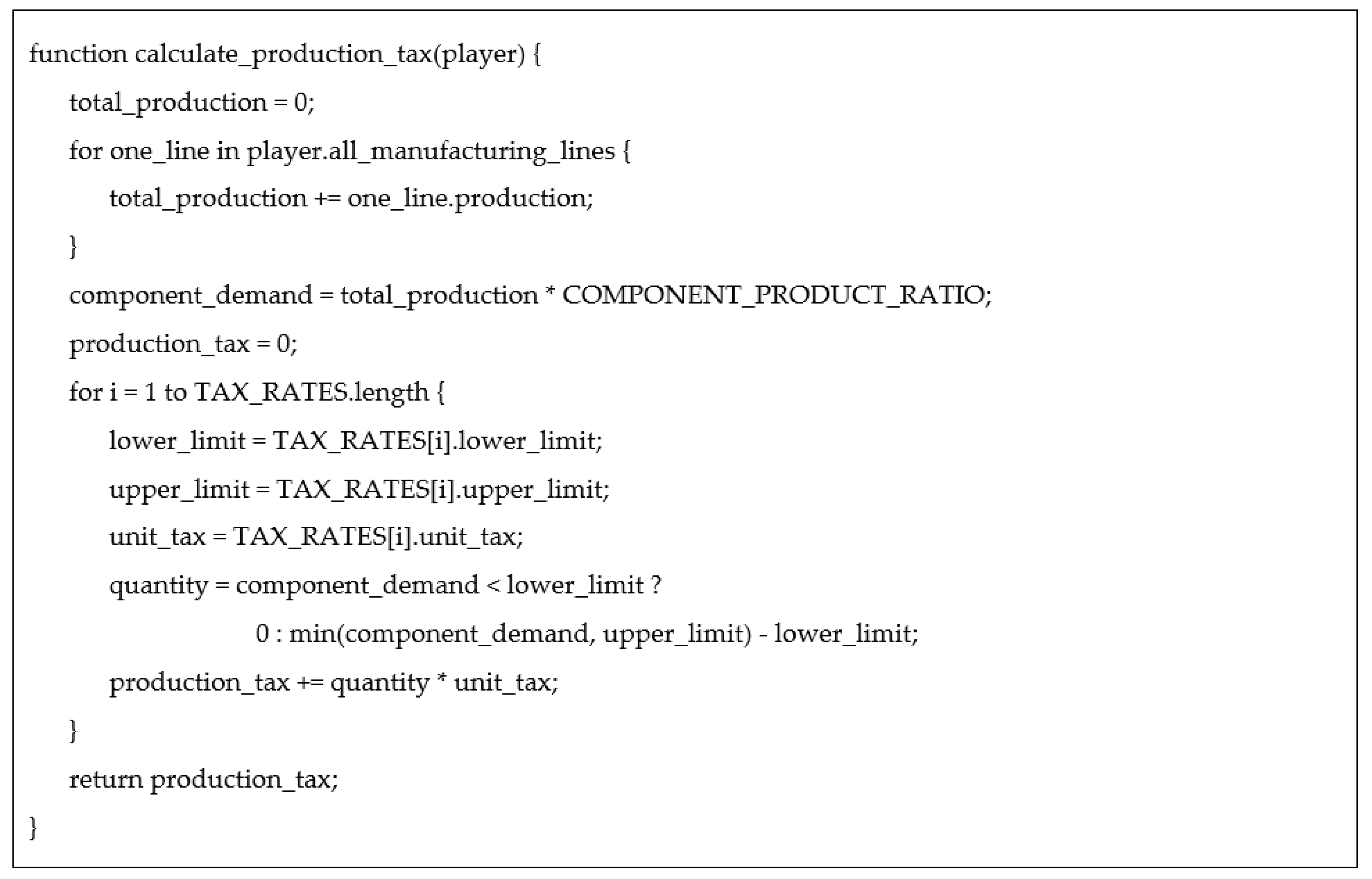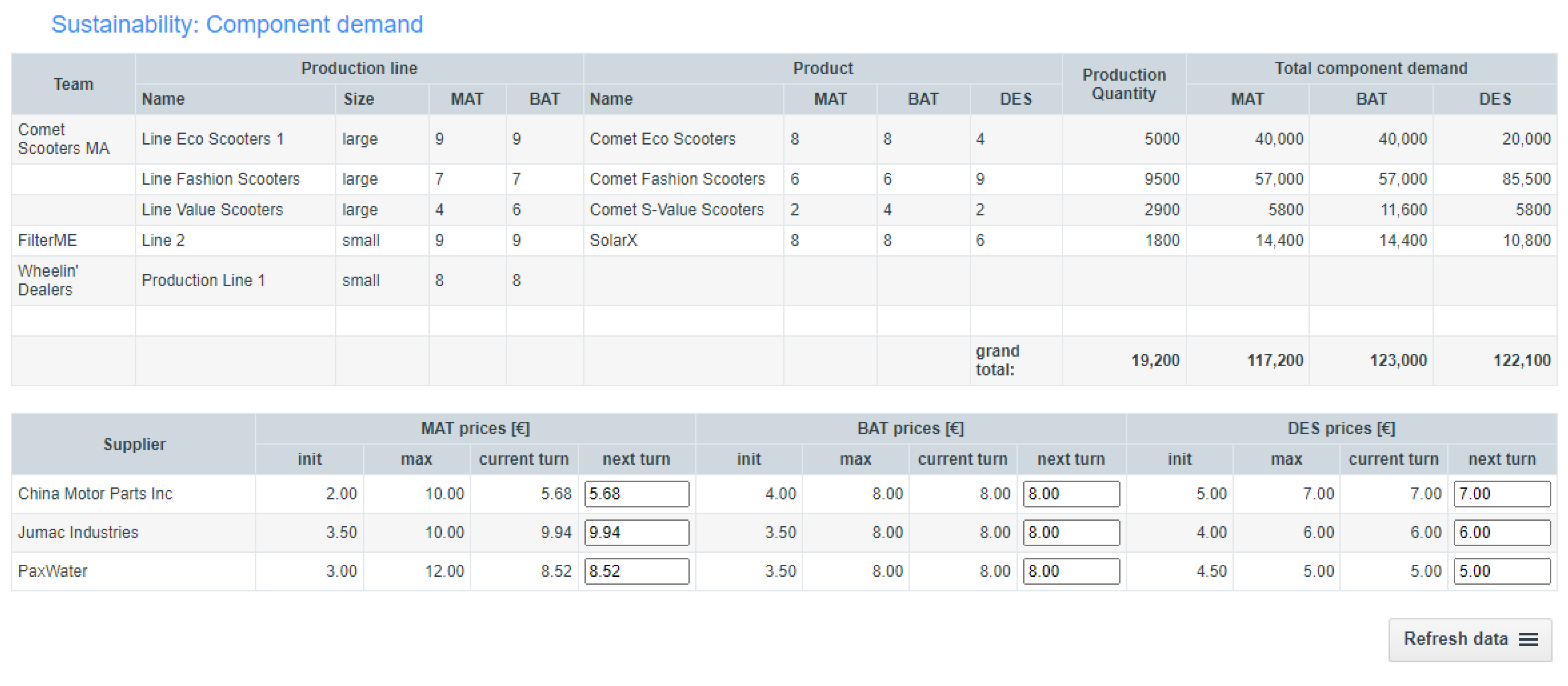Implementing Sustainability into Virtual Simulation Games in Business Higher Education
Abstract
:1. Introduction
2. Materials and Methods
2.1. Sustainability
2.2. Virtual Simulation Business Games as Teaching Tools in Business Higher Education
3. Results—Implementing Sustainability Aspects into Business Simulator
3.1. Assumptions and Pseudocodes
- -
- Our simulation is based on an IT solution based on software designed by a project team. Our simulation does not exist physically, but the software creates it;
- -
- Our simulation is an online simulation;
- -
- Within our simulation, we created a fictional market as close to a real market as possible, albeit a fictional one.
- -
- The production aspect has the form of the Cobb—Douglas function: the manufacturing cost depends on the human labor cost and the capital cost.
- -
- Labor effectiveness depends on the number of employees, remuneration, and additional benefits and training; however, the labor supply (number of employees available to be hired) is unlimited.
- -
- The number of components necessary to complete the final product is unlimited, and the component price is fixed.
- -
- A progressive environmental tax depending on the manufacturing volume has been introduced.
- -
- The cost of production factors is variable; in particular, the cost of materials and components is variable and depends on the demand volume.
3.2. First Insights of the Testing Students
4. Discussion
Author Contributions
Funding
Institutional Review Board Statement
Informed Consent Statement
Data Availability Statement
Conflicts of Interest
References
- Menon, S.; Suresh, M. Development of assessment framework for environmental sustainability in higher education institutions. Int. J. Sustain. High. Educ. 2022; ahead-of-print. [Google Scholar] [CrossRef]
- Velazquez, L.; Munguia, N.; Platt, A.; Taddei, J. Sustainable university: What can be the matter? J. Clean. Prod. 2006, 14, 810–819. [Google Scholar] [CrossRef]
- Blewitt, J. Higher education for a sustainable world. Educ. Train. 2010, 52, 477–488. [Google Scholar] [CrossRef]
- Ortiz-de-Urbina-Criado, M.; Mora-Valentín, E.-M.; Nájera-Sánchez, J.-J. Sustainability and entrepreneurship: Emerging opportunities for business and management education. J. Entrep. Emerg. Econ. 2022; ahead-of-print. [Google Scholar] [CrossRef]
- Dima, A.-M.; Meghisan-Toma, G.-M. Reserch on implementing education for sustainable development. Proc. Int. Conf. Bus. Excell. 2018, 12, 300–310. [Google Scholar] [CrossRef]
- Rusinko, C.A. Integrating sustainability in higher education: A generic matrix. Int. J. Sustain. High. Educ. 2010, 11, 250–259. [Google Scholar] [CrossRef]
- Kalansooriya, J.; Ariyawansa, R.; Kumara, U. Sustainability: Definitions Vs Interpretations. Int. J. Sci. Res. Publ. 2020, 10, 334–341. [Google Scholar] [CrossRef]
- Purvis, B.; Mao, Y.; Robinson, D. Three pillars of sustainability: In search of conceptual origins. Sustain. Sci. 2019, 14, 681–695. [Google Scholar] [CrossRef]
- Wiersum, K.F. 200 years of sustainability in forestry: Lessons from history. Environ. Manag. 1995, 19, 321–329. [Google Scholar] [CrossRef]
- Klarin, T. The Concept of Sustainable Development: From its Beginning to the Contemporary Issues. Zagreb Int. Rev. Econ. Bus. 2018, 21, 67–94. [Google Scholar] [CrossRef] [Green Version]
- Barbier, E.B. The concept of sustainable economic development. Econ. Sustain. 2017, 14, 87–96. [Google Scholar] [CrossRef]
- Redclift, M. Sustainable development (1987–2005): An oxymoron comes of age. Sustain. Dev. 2005, 13, 212–227. [Google Scholar] [CrossRef]
- Sneddon, C.S. “Sustainability” in ecological economics, ecology and livelihoods: A review. Prog. Hum. Geogr. 2000, 24, 521–549. [Google Scholar] [CrossRef]
- Hallin, A.; Karrbom-Gustavsson, T.; Dobers, P. Transition towards and of sustainability—Understanding sustainability as performative. Bus. Strategy Environ. 2021, 30, 1948–1957. [Google Scholar] [CrossRef]
- Elkington, J. Towards the sustainable corporation: Win-win-win business strategies for sustainable development. Corp. Environ. Responsib. 1994, 36, 90–100. [Google Scholar] [CrossRef]
- Álvarez-Herranz, A.; Macedo-Ruíz, E. An evaluation of the three pillars of sustainability in cities with high airbnb presence: A case study of the city of Madrid. Sustainability 2021, 13, 220. [Google Scholar] [CrossRef]
- Muralikrishna, I.V.; Manickam, V. Environmental Management; Butterworth-Heinemann: Oxford, UK, 2017. [Google Scholar]
- Clune, W.H.; Zehnder, A.J.B. The evolution of sustainability models, from descriptive, to strategic, to the three pillars framework for applied solutions. Sustain. Sci. 2020, 15, 1001–1006. [Google Scholar] [CrossRef]
- Clune, W.H.; Zehnder, A.J.B. The Three Pillars of Sustainability Framework: Approaches for Laws and Governance. J. Environ. Prot. 2018, 9, 211–240. [Google Scholar] [CrossRef]
- Kattumuri, R. Sustaining natural resources in a changing environment: Evidence, policy and impact. Contemp. Soc. Sci. 2018, 13, 1–16. [Google Scholar] [CrossRef]
- Gylfason, T. Natural resources, education, and economic development. Eur. Econ. Rev. 2001, 45, 847–859. [Google Scholar] [CrossRef]
- Koistinen, K.; Teerikangas, S.; Mikkilä, M.; Linnanen, L. Active sustainability actors: A life course approach. Sustain. Dev. 2020, 28, 208–223. [Google Scholar] [CrossRef]
- Hartter, J.; Hamilton, L.C.; Boag, A.E.; Stevens, F.R.; Ducey, M.J.; Christoffersen, N.D.; Oester, P.T.; Palace, M.W. Does it matter if people think climate change is human caused? Clim. Serv. 2018, 10, 53–62. [Google Scholar] [CrossRef]
- Maibach, E.; Myers, T.; Leiserowitz, A. Climate scientists need to set the record straight: There is a scientific consensus that human-caused climate change is happening. Earth’s Future 2014, 2, 295–298. [Google Scholar] [CrossRef]
- Chen, B.; Wu, C.; Liu, X.; Chen, L.; Wu, J.; Yang, H.; Luo, T.; Wu, X.; Jiang, Y.; Jiang, L.; et al. Seasonal climatic effects and feedbacks of anthropogenic heat release due to global energy consumption with CAM5. Clim. Dyn. 2019, 52, 6377–6390. [Google Scholar] [CrossRef]
- Campa, R. The Sociology of Global Warming: A Scientometric Look. Studia Hum. 2021, 10, 18–33. [Google Scholar] [CrossRef]
- Burkett, J.P. Microeconomics: Optimization, Experiments, and Behavior; Oxford University Press: Oxford, UK, 2006. [Google Scholar]
- Begg, D.; Vernasca, G.; Dornbusch, R.; Fischer, S. Economics, 12th ed.; McGraw-Hill Education: New York, NY, USA, 2020. [Google Scholar]
- Varian, H.R. Intermediate Microeconomics: A Modern Approach, 9th ed.; W.W. Norton & Company: New York, NY, USA, 2019. [Google Scholar]
- Yu, M.; Zhao, R. Sustainability and firm valuation: An international investigation. Int. J. Account. Inf. Manag. 2015, 23, 289–307. [Google Scholar] [CrossRef]
- Singal, M. The Link between Firm Financial Performance and Investment in Sustainability Initiatives. Cornell Hosp. Q. 2014, 55, 19–30. [Google Scholar] [CrossRef]
- Martínez-Ferrero, J.; Frías-Aceituno, J.V. Relationship Between Sustainable Development and Financial Performance: International Empirical Research. Bus. Strategy Environ. 2015, 24, 20–39. [Google Scholar] [CrossRef]
- Alshehhi, A.; Nobanee, H.; Khare, N. The Impact of Sustainability Practices on Corporate Financial Performance: Literature Trends and Future Research Potential. Sustainability 2018, 10, 494. [Google Scholar] [CrossRef]
- Guardia, J.J.; Del Olmo, J.L.; Roa, I.; Berlanga, V. Innovation in the teaching-learning process: The case of Kahoot! Horizon 2019, 27, 35–45. [Google Scholar] [CrossRef]
- Alsawaier, R.S. The effect of gamification on motivation and engagement. Int. J. Inf. Learn. Technol. 2018, 35, 56–79. [Google Scholar] [CrossRef]
- Smith, K.; Lovgren, R. Empirical evidence of deep learning in learning communities. J. Appl. Res. High. Educ. 2018, 10, 311–321. [Google Scholar] [CrossRef]
- Ninaus, M.; Greipl, S.; Kiili, K.; Lindstedt, A.; Huber, S.; Klein, E.; Karnath, H.-O.; Moeller, K. Increased emotional engagement in game-based learning—A machine learning approach on facial emotion detection data. Comput. Educ. 2019, 142, 103641. [Google Scholar] [CrossRef]
- Stamatelatos, A.; Brooks, R. Simulated business effectiveness: Learning and performance outcomes. Educ. Train. 2020, 62, 1015–1036. [Google Scholar] [CrossRef]
- Cheng, Y.-M. Can gamification and interface design aesthetics lead to MOOCs’ success? Educ. Train. 2021, 63, 1346–1375. [Google Scholar] [CrossRef]
- Furdu, I.; Tomozei, C.; Köse, U. Pros and Cons Gamification and Gaming in Classroom. BRAIN Broad Res. Artif. Intell. Neurosci. 2017, 8, 56–62. [Google Scholar]
- Ahmed, A.; Sutton, M.J.D. Gamification, serious games, simulations, and immersive learning environments in knowledge management initiatives. World J. Sci. Technol. Sustain. Dev. 2017, 14, 78–83. [Google Scholar] [CrossRef]
- Murillo-Zamorano, L.R.; López Sánchez, J.Á.; Godoy-Caballero, A.L.; Bueno Munoz, C. Gamification and active learning in higher education: Is it possible to match digital society, academia and students’ interests? Int. J. Educ. Technol. High. Educ. 2021, 18, 15. [Google Scholar] [CrossRef]
- Çeker, E.; Özdamlı, F. What “Gamification” is and what it’s not. Eur. J. Contemp. Educ. 2017, 6, 221–228. [Google Scholar]
- Vankúš, P. Influence of Game-Based Learning in Mathematics Education on Students’ Affective Domain: A Systematic Review. Mathematics 2021, 9, 986. [Google Scholar] [CrossRef]
- Holmes, J.B.; Gee, E.R. A framework for understanding game-based teaching and learning. Horizon 2016, 24, 1–16. [Google Scholar] [CrossRef]
- Nadolny, L.; Valai, A.; Jaramillo Cherrez, N.; Elrick, D.; Lovett, A.; Nowatzke, M. Examining the characteristics of game-based learning: A content analysis and design framework. Comput. Educ. 2020, 156, 103936. [Google Scholar] [CrossRef]
- Looyestyn, J.; Kernot, J.; Boshoff, K.; Ryan, J.; Edney, S.; Maher, C. Does gamification increase engagement with online programs? A systematic review. PLoS ONE 2017, 12, e0173403. [Google Scholar] [CrossRef]
- Perini, S.; Luglietti, R.; Margoudi, M.; Oliveira, M.; Taisch, M. Learning and motivational effects of digital game-based learning (DGBL) for manufacturing education—The Life Cycle Assessment (LCA) game. Comput. Ind. 2018, 102, 40–49. [Google Scholar] [CrossRef]
- Kaliappen, N. Educational Benefits of Using Business Strategy Game (BSG) in Teaching and Learning Strategic Management. Int. J. Emerg. Technol. Learn. 2019, 14, 209–214. [Google Scholar] [CrossRef]
- Zantow, K.; Knowlton, D.S.; Sharp, D.C. More Than Fun and Games: Reconsidering the Virtues of Strategic Management Simulations. Acad. Manag. Learn. Educ. 2005, 4, 451–458. [Google Scholar] [CrossRef]
- Mitchell, R.C. Combining Cases and Computer Simulations in Strategic Management Courses. J. Educ. Bus. 2004, 79, 198–204. [Google Scholar] [CrossRef]
- Mammadova, S. Lifelong Education in Business: Role of Simulation Games in the Teaching Process. Turk. J. Comput. Math. Educ. 2021, 12, 1834–1839. [Google Scholar] [CrossRef]
- Dicheva, D.; Dichev, C.; Agre, G.; Angelova, G. Gamification in Education: A Systematic Mapping Study. Educ. Technol. Soc. 2015, 18, 75–88. [Google Scholar] [CrossRef]
- Buckley, P.; Doyle, E.; Doyle, S. Game On! Students’ Perceptions of Gamified Learning. Educ. Technol. Soc. 2017, 20, 1–10. [Google Scholar]
- Liu, B.; Wang, J. Demon or angel: An exploration of gamification in management. Nankai Bus. Rev. Int. 2019, 11, 317–343. [Google Scholar] [CrossRef]
- Pászto, V.; Pánek, J.; Glas, R.; van Vught, J. Spationomy Simulation Game—Playful Learning in Spatial Economy Higher Education. ISPRS Int. J. Geo-Inf. 2021, 10, 74. [Google Scholar] [CrossRef]
- Rooney-Varga, J.N.; Kapmeier, F.; Sterman, J.D.; Jones, A.P.; Putko, M.; Rath, K. The Climate Action Simulation. Simul. Gaming 2020, 51, 114–140. [Google Scholar] [CrossRef] [Green Version]
- Ivens, S.; Wiese, G.; Dittert, K.; Mußho, O.; Oberle, M. Bringing Policy Decisions to the People-Education for Sustainable Development through a Digital Simulation Game. Sustainability 2020, 12, 8743. [Google Scholar] [CrossRef]
- Tsai, J.-C.; Liu, S.-Y.; Chang, C.-Y.; Chen, S.-Y. Using a Board Game to Teach about Sustainable Development. Sustainability 2021, 13, 4942. [Google Scholar] [CrossRef]
- Gaweł, A.; Pietrzykowski, M. (Eds.) The Strategic Management: Virtual Game Method in Business Education; Wydawnictwo IUSatTAX: Warszawa, Poland, 2014. [Google Scholar]
- Wach-Kąkolewicz, A.; Muffoletto, R. (Eds.) Perspectives on Computer Gaming in Higher Education; Bogucki Wydawnictwo Naukowe: Poznań, Poland, 2016. [Google Scholar]








Publisher’s Note: MDPI stays neutral with regard to jurisdictional claims in published maps and institutional affiliations. |
© 2022 by the authors. Licensee MDPI, Basel, Switzerland. This article is an open access article distributed under the terms and conditions of the Creative Commons Attribution (CC BY) license (https://creativecommons.org/licenses/by/4.0/).
Share and Cite
Gawel, A.; Strykowski, S.; Madias, K. Implementing Sustainability into Virtual Simulation Games in Business Higher Education. Educ. Sci. 2022, 12, 599. https://doi.org/10.3390/educsci12090599
Gawel A, Strykowski S, Madias K. Implementing Sustainability into Virtual Simulation Games in Business Higher Education. Education Sciences. 2022; 12(9):599. https://doi.org/10.3390/educsci12090599
Chicago/Turabian StyleGawel, Aleksandra, Sergiusz Strykowski, and Konstantinos Madias. 2022. "Implementing Sustainability into Virtual Simulation Games in Business Higher Education" Education Sciences 12, no. 9: 599. https://doi.org/10.3390/educsci12090599
APA StyleGawel, A., Strykowski, S., & Madias, K. (2022). Implementing Sustainability into Virtual Simulation Games in Business Higher Education. Education Sciences, 12(9), 599. https://doi.org/10.3390/educsci12090599







